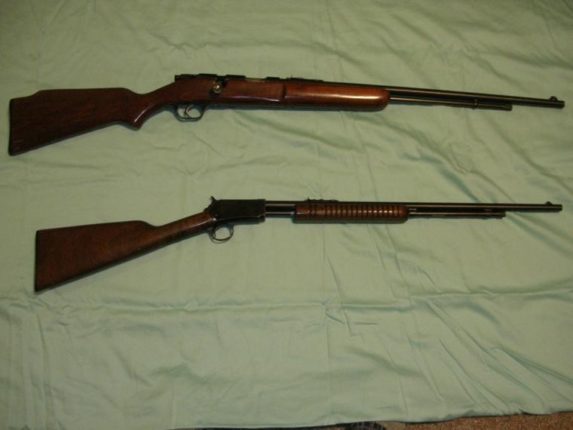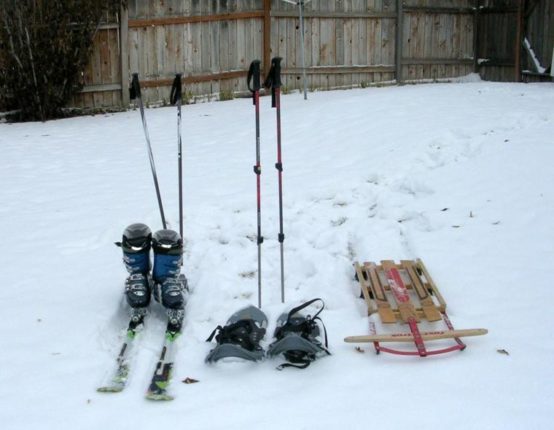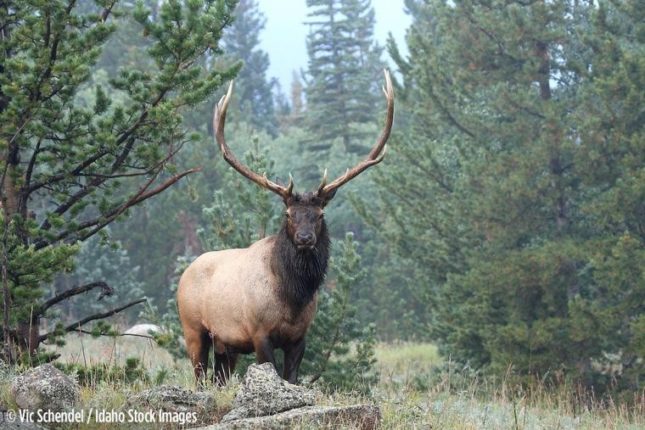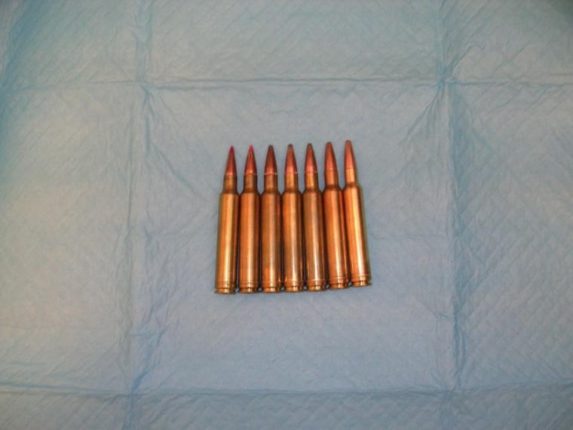If I remember correctly, I was about 9 years old when I saw my mother’s old skis at my grandfather Andersen’s house in Blackfoot and took them home to learn to ski. A pair of bamboo poles came with the skis, and I didn’t have to buy ski boots because t…
Author: By Smokey Merkley
Growing up to be a hunter
When I was born, World War II was a couple of months from ending. My father was stationed at Barksdale Field outside of Bossier City, Louisiana, as a high-altitude physiologist and trainer of B-26 bomber crews on the oxygen systems in the airplane.
When the war was over, he immediately was accepted into the University of Utah Medical School. After medical school, he then spent two more years specializing as an intern in general surgery for the Coast Guard in Staten Island, New York, and then the Wellborn Clinic in Evansville, Indiana.
By the time we finally got back to Idaho and settled in Pocatello, I was 7 years old and in the second grade. Normally, the children in my grandfather Merkley’s family were taught firearm safety and instructed in principles of marksmanship and to handle firearms, specifically rifles, before 7 years of age. I got a late start in that instruction, so my father and his brothers made sure I was brought up to speed as quickly as possible.
My Uncle Floyd and my Grandmother Merkley’s brother had farms in Blackfoot and Wapello, Idaho, where we could shoot firearms and ride horses. Within a few years, my father bought some farm property off the old Bannock Highway where we could shoot firearms as well as ride our own horses.
By the time I was 10 years old, I had a Savage Model 5 .22 rim-fire rifle and my father was taking me to the Arco Desert to hunt jackrabbits in the sage brush between the highway and some farms whose owners knew the Merkley family and had given my dad permission to hunt the rabbits that constantly saw the farms as an ideal place for food. That preliminary training with a .22 rifle ingrained the basics of firearm safety, marksmanship and hunting into me.
At first it was quite a challenge to try to line up the sights on moving rabbits and hit them, but constant practice began to pay off. I eventually was able to quickly line up the sights, fire and hit my target in one smooth fluid motion. I also started to became more aware of my surroundings and saw more rabbits than I had when I first started learning to hunt them. I still own that .22 rim-fire rifle, although I came to favor my dad’s Winchester Model 62 .22 pump rifle.
Those first lessons in firearm safety in the field, hunting and awareness of my surroundings served me well when at 11 years of age I received a high-powered rifle for Christmas in preparation for deer hunting with my father and Uncle Veral during the next fall deer season.
My father loved jackrabbit hunting, but wasn’t particularly fond of hunting deer, elk, pronghorn, mountain sheep or birds. He did, however, feel he had a responsibility to train me the way his father and older brothers had trained him, because there wasn’t a state hunter safety program at that time.
Big game hunting was a great adventure for me. It was a time my father gave up some of his time to camp and hunt with his brothers and me for a few days while another doctor covered for him and looked after his patients.
Early on, I realized that I wanted a rifle that would reach out and hit with more authority than the one I received for my 11th Christmas. When I was 16, a friend of my father asked to go hunting with us. He brought a .300 Weatherby Magnum Mark V as his hunting rifle. He got his deer at about 500 yards with one shot. The deer dropped as if he had been pole axed. Late that afternoon after we returned to camp, he noticed me looking at his rifle and asked if I would like to shoot it. I said I would and he set up a can full of water at about 100 yards for me to shoot at. At the shot, the can full of water exploded, the but of the rifle hit my shoulder hard, and rose upward, hitting me in the jaw hard enough to make me check to be sure my jaw was OK. I handed the rifle back to him and said, “Wow, I gotta get me one of these.” My father said that was OK, but I had to buy it myself since he was through buying firearms for me. To this day, I hunt deer with my father’s Remington Model 721 in .30-06 Springfield and I bought my own .300 Weatherby Magnum to hunt larger ungulates and even deer or pronghorn if I think I will be shooting at 300 yards or more. I also learned to shoot it without hurting myself. I now consider the recoil of a .300 Weatherby pretty tolerable and my grandsons who are 16 or older are comfortable shooting it also.
However, I think those jackrabbit hunts with .22 rim-fire rifles with my dad were some of the best hunting memories I have.
Smokey Merkley was raised in Idaho and has been hunting since he was 10 years old. He can be contacted at mokeydo41245@hotmail.com.
Winter activities abound in Southeast Idaho
For those of you who took advantage of the archery, any weapon seasons and controlled hunts — some that lasted into November — hopefully you were successful in harvesting the game you hunted and had a good time with family and friends.
There are still some opportunities for white-tailed deer in the panhandle units of the state and elk hunting with muzzle loaders, as well as archery hunting into late December. Check your Idaho Big Game 2017-18 Seasons and Rules Handbook available at most sporting goods stores and Fish and Game offices if you want to legally hunt for another month.
For those who think winter puts a damper on outdoor recreation, you couldn’t be more mistaken. After this past snowfall that left quite a bit of snow in the valley and a lot of snow in the mountains, there is a lot to look forward to. Pebble Creek Ski Area in Inkom as well as other ski areas around Idaho are encouraged by the snow fall and some may open earlier than they normally do this winter. I believe Grand Targhee Ski Resort, just up the road from Driggs, has already opened. Pebble Creek was open this past weekend and will open again Friday, when it plans to open for the whole season. The East Fork Mink Creek Nordic Center outside of Pocatello is now open as well.
Idaho State University maintains a series of yurts that sleep up to six people in the mountains east of Inkom that folks can snowshoe or cross-country ski into and spend the night. The yurts are equipped with a log-fueled stove for warmth as well as a smaller Coleman-type stove for cooking.
The Catamount Yurt may be the easiest to access for those who aren’t used to snowshoeing or cross-country skiing most of the day. It is only about 2 miles southeast of McNabb Road, but in the winter the road isn’t plowed up to the sheep pens, so you might have to add an additional mile of snowshoeing or cross-country skiing. There is quite a bit of privately owned land around the Catamount Yurt, which is situated on Bureau of Land Management land. Most of that land has a no trespassing signs posted on it, so be sure to ask at the ISU Outdoor Adventure Center how they want people to travel to the yurt.
There is also a yurt up Inman Canyon for those who are in good condition and want a longer more scenic route through the mountains before getting to the yurt. The ISU Outdoor Adventure Center and equipment rental office can supply you with maps showing you how to get to the various yurts and should be able to answer any questions about the routes into and out of the yurts.
Sledding is a popular winter sport and there are numerous places around Pocatello to go sledding, particularly in — but not restricted to — the mountains in the Mink Creek area.
If you own a snowmobile, you have access to a lot of BLM and U.S. Forest Service land, but make sure you know where you can and can’t ride and don’t enter or cross private property without permission.
Ice fishing is popular in Idaho. I have never tried it because I keep worrying about falling through the ice. but I see a lot of people at Devils Creek Reservoir and other lakes and ponds happily sitting outside or in ice fishing huts during most of the winter months.
Another idea that might appeal to some is going to Yellowstone National Park and snowmobiling to Old Faithful to see it erupt in the winter. There is also a snow coach that leaves the Stage Coach Inn in West Yellowstone early in the morning and takes people to Old Faithful. When you are dropped off back at the inn later in the day, you can eat at any of West Yellowstone’s fine restaurants and then soak in the hot tub area at the inn. West Yellowstone is an interesting city and the park is gorgeous during the winter months.
Ice skating is a lot of fun and there are a couple of places in Pocatello where they try to have ice skating rinks when the temperature is low enough. I’m wondering if the new recreation center in Pocatello might try to provide an ice skating rink.
If you haven’t soaked in the hot pots at Lava Hot Springs during the winter months, try it. You just might become addicted to cold weather and hot pots for soothing all the muscle aches that come from skiing and other activities.
So get outdoors and enjoy the winter this year. Don’t be a couch potato and sit around and watch football and basketball all winter while your physical conditioning deteriorates.
Smokey Merkley was raised in Idaho and has been hunting since he was 10 years old. He can be contacted at mokeydo41245@hotmail.com.
Dealing with hypothermia
We had what I perceived as a pretty warm hunting season from Oct. 10 to 20. A couple of the evenings were pretty cool, but nobody I am aware of felt cold enough to mention they were cold. As a matter of fact, I packed clothes, gloves and hand and pocket warmers I never needed. I basically did very well with boots, pants and a long-sleeved T-shirt with a light pull-over jacket with hood. During the day, I put the jacket in my day pack because I didn’t need it.
Those who will continue elk hunting during November should experience colder days and nights than the temperatures during October. If you are planning to camp while hunting in November, your vehicle might be quite a ways away if you start to experience hypothermia — the dangerous lowering of your body’s temperature.
Cold affects not just one or two specific tissues or functions of the exposed person but affects the whole physiological economy in a sometimes subtle, yet always complex fashion.
Under cold conditions, humidity plays a minor role, unless the skin is artificially wetted through rain, perspiration or falling in the creek. Should this occur, the resulting evaporation cooling may exceed all other factors in importance. A person immersed in sub-arctic 40-degree water can be cooled beyond recovery in about 20 to 40 minutes or approximately 10 to 20 minutes in 32-degree water. A person in wet cotton clothing because of perspiration or rain must be considered nearly immersed in water and should act accordingly.
The sooner wet clothing can be removed and dry clothing put on, the sooner a person can regain some warmth. To the outdoorsman who depends on the clothing worn to stay dry and warm, the choice of clothing immediately available in case of the need to change in a hurry, should have the highest priority. Because of weight limitations, weather factors, seasonal conditions and the environment, clothing must serve several purposes, yet be able to withstand the abuse of the rough, rugged environment. Several layers of easy-on, easy-off clothing can offer layers of dead air for insulation between the fabrics. Wool is traditionally preferred because it is warm even when wet, but it is poor protection from wind, so a good wind-proof garment should be the outer layer worn.
If someone in your group exhibits signs of hypothermia, remove wet clothes, hats, gloves, shoes and socks and replace with dry clothes and blankets. Protect against wind and drafts. Move to a warm dry shelter as soon as possible. If the victim is conscious and you have warm liquids that do not contain caffeine, you can offer it to them. Do not give a victim of even mild hypothermia symptoms alcoholic beverages. Caffeine and alcohol speed up heat loss.
Any time a person exhibits signs of hypothermia, as the body cools, symptoms will indicate the severity of the situation. Normal body temperature is 98.6 degrees. If the body temperature drops to 96 degrees, shivering begins and metabolism increases. At 94 degrees, gross motor skills are impaired. At 92 degrees, severe shivering begins and walking becomes difficult. At 90 degrees, convulsive shivering begins and the inability to stand up will be experienced. Finally, at 89 degrees body temperature, shivering stops and the individual will become comatose.
A person who is exhibiting any signs of hypothermia is in trouble. Immediate action to restore body heat is critical, so make sure you and the members of your group are prepared to act quickly to restore body heat and get the victim to professional medical help if necessary.
Many people don’t realize how soon a person will be in serious trouble if they don’t immediately remedy the situation when body temperature begins to drop.
Stay safe and stay warm. If a member of your group starts to show signs of hypothermia, get them warm fast or get medical assistance while there is still time.
Smokey Merkley was raised in Idaho and has been hunting since he was 10 years old. He can be contacted at mokeydo41245@hotmail.com.
The .30-30 Winchester
Do you Know what America’s favorite deer rifle is? I don’t know what it is now, with all the choices available to hunters, but from 1895 to the 1950s and ’60s it was the .30-30 Winchester center fire or .30 WCF as it was first called. Now we just call it the .30-30 Winchester.
In 1835, it was originally manufactured as a lever-action rifle with a tubular magazine under the barrel. It was the first small-bore sporting rifle designed for smokeless powder. Because the cartridges were loaded one in front of the other in the magazine, the bullets were either round nosed or flat nosed to avoid ignition of cartridges in the magazine, which would destroy the rifle and ruin the hunter’s day. However, Hornady has recently been manufacturing a 160-grain bullet with its flex tip technology for the .30-30 Winchester that has a spire-point tip, a higher ballistic coefficient and is safe to use in tubular magazines. Hornady calls the new bullets LEVERevolution bullets, and they have the potential of improving standard .30-30 performance in lever-action rifles out to 200 yards.
I usually load my .30-30 with 170-grain flat-nosed bullets at 2,227 feet per second and 1,873 foot-pounds of energy at the muzzle. Round-nosed and flat-nosed bullets create more air resistance, making the lever-action .30-30s decent 200-yard hunting rifles but the 170-grain bullet drops fast and loses momentum and foot pounds of energy past 200 yards. By 300 yards, the bullet has dropped 20 inches, and by 400 yards, it has dropped 58 inches.
Since 1,873 foot-pounds of energy is only about 400 foot-pounds of energy above that recommended for elk or moose hunting, it is recommended that the .30-30 be restricted to 100 yards and no more than 150 yards for the larger ungulates. In Canada, the .30-30 is used on moose and caribou using bolt-action rifles with spire-point bullets, but I personally think one should consider moving up to a .30-06 for game larger than deer or pronghorn.
Still, the .30-30 is a popular hunting rifle because of its good accuracy and light recoil, which is about 11 foot pounds of energy coming back at the hunter at 9.7 foot pounds using a 170-grain bullet.
Since I write a lot about the 700 Remington Magnum, .30-06, .300 Winchester Magnum, 300 Weatherby Magnum etc., I am sometimes asked if I even still own a .30-30 Winchester lever-action rifle? The answer is an emphatic yes. I own the original model 94 Winchester I used when I first started going hunting for deer, and my wife inherited a Model 64 lever-action .30-30 from her father.
I always take the .30-30 Winchester with me when I go deer hunting in case I end up hunting in heavy brush or sspen stands where a light, shorter rifle is preferred and the distance to target is likely to be 100 yards or less — sometimes a lot less.
I also like to lend my .30-30 to a couple of my grandchildren who probably aren’t ready to hunt with even a .30-06, which recoils twice as hard as the .30-30.
Whenever I am not hunting but want a rifle with me when going into some mountain property my family has owned for a lot of years, the .30-30 Winchester gets the nod. I have a sling on it and it is light and easy to carry if I am hiking, scouting for game prior to the hunting season or just want the reassurance of a rifle with adequate power out to 200 yards.
The .30-30 Winchester lever action may be older than my Aunt Doris, but it still does what it was designed to do within 200 yards, and it does it well. It definitely has an important place in and out of my rifle vault.
Smokey Merkley was raised in Idaho and has been hunting since he was 10 years old. He can be contacted at mokeydo41245@hotmail.com.
Idaho elk hunting: What you should know
The outlook for elk hunting in Idaho for 2018 is fair to excellent with some zones in the central mountains reporting elk populations below objectives. Elk hunting in Idaho is managed in 28 zones.Hunters can pick up a general A or B tag. The A tag prov…
What do you expect from your ammunition?
If you are planning on hunting big game this year with a rifle, I assume you know what caliber of rifle you plan to use. There are certainly many fine choices of rifle calibers to choose from depending on how far you expect to have to shoot, how much r…
What do you expect from your ammunition?
If you are planning on hunting big game this year with a rifle, I assume you know what caliber of rifle you plan to use. There are certainly many fine choices of rifle calibers to choose from depending on how far you expect to have to shoot, how much r…
Polymer-coating of bullets and polymer composite bullets
About 20 years ago American companies that produce high-powered rifle ammunition started using polymer tips on some of their bullets to achieve better flight characteristics during long-range shooting.
The polymer tips were easier to form than lead tips, and when combined with high ballistic efficient bullets with boat tails, flatter trajectories were obtained and more foot pounds (ft./lbs.) of energy were retained at distance. The primary problem with polymer tips was that they tended to warp due to extreme heat produced by velocities over 2,000 feet per second (FPS), affecting accuracy at several hundred yards.
Hornady ELD ammo and Scirocco II are the two polymer ballistic tip bullets I am familiar with. The ELD is guaranteed to retain it’s shape far beyond 400 yards with it’s Heat Shield Technology and the Scirocco II bullet seems to resist warping when fired at 3,000 FPS or a little more from my .300 WBY Mag. Both bullets have worked well for me out to a little more than 400 yards. Accuracy has been very satisfactory when I manage to do my part. I have also heard some high praise for a Nosler ballistic tip bullet, but have not had any personal experience with it.
A couple of years ago I was at the Oregon Trail Gun Club watching a cowboy shooting event. One of the venders that was also there, was giving out samples of polymer-coated bullets.
Polymer-coated bullets have been used for about two decades outside the United States. Advantages of polymer coated bullets are less friction between the bullet and the bore, less smoke, less debris such as lead left in the barrel, no toxic off-gassing, contains no Moly-Disulfide to gum up your dies, works great in bullet feeders, great for indoor shooting where lead bullets are restricted, non abrasive to the barrel, coating does not rub off on your hands, and poly-coating does not build up in the barrel.
The most common source for polymer-coated bullets is Hi-Tek, made by J&M Specialty Products from Australia. The representative that was handing out polymer-coated bullet samples was from Leatherhead Bullets which purchased them from J&K Specialties, and is now in the process of merging with Gallant Bullets in Utah.
Some companies use their own proprietary polymer, moly, or Teflon based mixtures. However, Teflon may be illegal since it is commonly used in Armor Piercing bullets.
Polymer-coating is generally good at velocities blow 2,000 FPS with1,200 to 1,500 FPS being the norm. this makes polymer coated bullets primarily good for pistol velocities with some rifle ammunition such as .300 Blackout, .45-70, and .30-30 Winchester included. Velocities above 2,000 FPS create enough heat to warp the polymer coating, so it is recommended that polymer coated bullets not be used with ammunition that generates more than 2000 FPS muzzle velocities.
Recently a company, Polycase, has come out with bullets that are a mixture of powdered copper and polymer and are produced by injection molding. The bullets come in two types, solid or fluted. The solid bullets are called, Round Nose Precision, and the fluted bullets are called Truncated Nose Precision. The ARX (Advanced Rotational Extreme) bullet has three flutes in the nose that redirect hydraulic forces laterally.
At this time, Polycase bullets come in, .380 Auto, 9mm Luger, .38 Special, .357 Magnum, .40 S&W, .45 Auto and .45 Colt for handguns. Polycase loads both the round nose and ARX bullets for it’s handgun calibers, and the ARX is used in low velocity rifle rounds. Ruger loads only the ARX bullets.
The ARX bullets do not expand. They rely on the flutes , combined with the bullet’s rotation, to create hydrostatic shock to create a large temporary wound channel during penetration.
Polycase claims that ARX bullets create temporary wound channels that match or exceed any bullet in the same caliber. The ARX bullets have significant penetration in gelatin but generally stop by 16 inches, thereby reducing the risk of over penetration.
The Polycase composite bullets are new enough that I haven’t seen them in stores yet. They tend to be about 25 percent lighter than lead bullets of the same caliber.
It is evident that polymer-coating of bullets and the technology of producing polymer composite bullets is moving forward. We can only wait and see if they become popular once they are more readily available.
Smokey Merkley was raised in Idaho and has been hunting since he was 10 years old. He can be contacted at mokeydo41245@hotmail.com.
Polymer-coating of bullets and polymer composite bullets
About 20 years ago American companies that produce high-powered rifle ammunition started using polymer tips on some of their bullets to achieve better flight characteristics during long-range shooting.
The polymer tips were easier to form than lead tips, and when combined with high ballistic efficient bullets with boat tails, flatter trajectories were obtained and more foot pounds (ft./lbs.) of energy were retained at distance. The primary problem with polymer tips was that they tended to warp due to extreme heat produced by velocities over 2,000 feet per second (FPS), affecting accuracy at several hundred yards.
Hornady ELD ammo and Scirocco II are the two polymer ballistic tip bullets I am familiar with. The ELD is guaranteed to retain it’s shape far beyond 400 yards with it’s Heat Shield Technology and the Scirocco II bullet seems to resist warping when fired at 3,000 FPS or a little more from my .300 WBY Mag. Both bullets have worked well for me out to a little more than 400 yards. Accuracy has been very satisfactory when I manage to do my part. I have also heard some high praise for a Nosler ballistic tip bullet, but have not had any personal experience with it.
A couple of years ago I was at the Oregon Trail Gun Club watching a cowboy shooting event. One of the venders that was also there, was giving out samples of polymer-coated bullets.
Polymer-coated bullets have been used for about two decades outside the United States. Advantages of polymer coated bullets are less friction between the bullet and the bore, less smoke, less debris such as lead left in the barrel, no toxic off-gassing, contains no Moly-Disulfide to gum up your dies, works great in bullet feeders, great for indoor shooting where lead bullets are restricted, non abrasive to the barrel, coating does not rub off on your hands, and poly-coating does not build up in the barrel.
The most common source for polymer-coated bullets is Hi-Tek, made by J&M Specialty Products from Australia. The representative that was handing out polymer-coated bullet samples was from Leatherhead Bullets which purchased them from J&K Specialties, and is now in the process of merging with Gallant Bullets in Utah.
Some companies use their own proprietary polymer, moly, or Teflon based mixtures. However, Teflon may be illegal since it is commonly used in Armor Piercing bullets.
Polymer-coating is generally good at velocities blow 2,000 FPS with1,200 to 1,500 FPS being the norm. this makes polymer coated bullets primarily good for pistol velocities with some rifle ammunition such as .300 Blackout, .45-70, and .30-30 Winchester included. Velocities above 2,000 FPS create enough heat to warp the polymer coating, so it is recommended that polymer coated bullets not be used with ammunition that generates more than 2000 FPS muzzle velocities.
Recently a company, Polycase, has come out with bullets that are a mixture of powdered copper and polymer and are produced by injection molding. The bullets come in two types, solid or fluted. The solid bullets are called, Round Nose Precision, and the fluted bullets are called Truncated Nose Precision. The ARX (Advanced Rotational Extreme) bullet has three flutes in the nose that redirect hydraulic forces laterally.
At this time, Polycase bullets come in, .380 Auto, 9mm Luger, .38 Special, .357 Magnum, .40 S&W, .45 Auto and .45 Colt for handguns. Polycase loads both the round nose and ARX bullets for it’s handgun calibers, and the ARX is used in low velocity rifle rounds. Ruger loads only the ARX bullets.
The ARX bullets do not expand. They rely on the flutes , combined with the bullet’s rotation, to create hydrostatic shock to create a large temporary wound channel during penetration.
Polycase claims that ARX bullets create temporary wound channels that match or exceed any bullet in the same caliber. The ARX bullets have significant penetration in gelatin but generally stop by 16 inches, thereby reducing the risk of over penetration.
The Polycase composite bullets are new enough that I haven’t seen them in stores yet. They tend to be about 25 percent lighter than lead bullets of the same caliber.
It is evident that polymer-coating of bullets and the technology of producing polymer composite bullets is moving forward. We can only wait and see if they become popular once they are more readily available.
Smokey Merkley was raised in Idaho and has been hunting since he was 10 years old. He can be contacted at mokeydo41245@hotmail.com.




